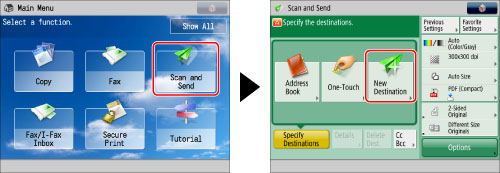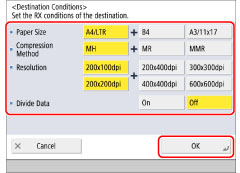Specifying Destinations by Entering an I-Fax Address
1.
Press [Scan and Send] → [New Destination].

2.
Press [I-Fax].

3.
Select the desired mode from the drop-down list.

|
[Simple]:
|
Sends scanned data as an image via the Internet.
|
|
[Full]:
|
Sends scanned data as an image via the Internet, and enables you to receive confirmation that your I-fax was sent successfully.
|
|
NOTE
|
|
To send using the Full mode, it must be supported on the recipient's machine. If you send using the Full mode, you can confirm whether your I-fax was sent successfully.
If you send documents using the Full mode to a machine that does not support the Full mode, delivery confirmation cannot be carried out. In this case, the job concerned is not considered complete even if the actual sending of the document is successful. Such jobs appear as <Waiting for TX result...> on the Status Monitor/Cancel screen until the time set for [Full Mode TX Timeout] in [E-Mail/I-Fax Settings] has lapsed. After the timeout, the job is moved to the log, and the result appears as <--> when delivery confirmation could not be verified. (See "Full Mode TX Timeout.")
You can confirm the delivery status of the document in [Status Monitor/Cancel] → [Send] → [Job Log]. If the document was received successfully, [OK] will be displayed, if it failed to send, [NG] will be displayed, and if the results cannot be confirmed, <--> will be displayed. In the Simple mode, delivery confirmation is disabled. Even if the delivery was successful, <--> will be displayed. However, if [Restrict Access to Other User Jobs] in [Management Settings] (Settings/Registration) is set to 'On', jobs sent by other users are displayed as asterisks ('********'), and they cannot be checked. If you are logged in as the Administrator, jobs for all users are displayed.
 |
4.
Press [I-Fax Address].
5.
Enter the I-fax address → press [OK].
|
NOTE
|
|
If you do not send documents via a server, and if the recipient's IP address is not registered with a DNS server, enter the domain name in the following format: (user) @ (the recipient's IP address).
|
6.
Press [Destination Conditions].
7.
Set the destination conditions → press [OK].

|
<Paper Size>:
|
Set the paper size that the recipient can receive. Specify this setting after checking whether the paper size of the data to send matches the specifications of the recipient's device.
[A4/LTR]: Sends with the A4/LTR size.
[A4/LTR] + [B4]: Sends with the A4/LTR size or B4 size.
[A4/LTR] + [A3/11x17]: Sends with the A4/LTR size or A3/11" x 17" size.
[A4/LTR] + [B4] + [A3/11x17]: Sends with the A4/LTR size, B4 size, or A3/11" x 17" size.
If the paper size of the scanned data is smaller than the sizes set in <Paper Size>, the data is sent with the smallest paper size set in <Paper Size> with blank margins.
If the paper size of the scanned data is larger than the sizes set in <Paper Size>, the data is reduced and sent with the largest paper size set in <Paper Size>.
|
|
<Compression Method>:
|
MH (Modified Huffman): This method scans and compresses extended areas of white and black dots.
MR (Modified Read): This method scans and compresses extended areas of white and black dots. Faster than MH.
MMR (Modified Modified Read): This method is an adaptation of Modified Read, originally for use in digital machines. Faster than MR.
|
|
<Resolution>:
|
Set the resolution that the recipient can receive.
|
|
<Divide Data>:
|
Select [On] if there is a function to combine divided data that is received, or [Off] if there is not.
If the size of the data being sent exceeds the value set for [Maximum Data Size for Sending], the data is divided when sent.
If the size of the data being sent exceeds the value set for [Maximum Data Size for Sending] when the Divide Data setting is set to 'Off', a sending error occurs. (See "Maximum Data Size for Send.")
|
|
IMPORTANT
|
|
Set the destination conditions according to the specifications of the recipient's machine. If the paper size of the data to send is larger than the paper sizes that can be used with the recipient's device, the image may be clipped or cut off.
Set the destination conditions according to the specifications of the recipient's machine. If you set conditions that the recipient's machine does not support, a transmission error may occur.
|
8.
Select one of the following for <Send via Server>.
|
[On]:
|
Sends documents via a server. You can send documents to destinations via the Internet in the same way as e-mail.
|
|
[Off]:
|
Does not send documents via a server. You can send large amounts of image data to a recipient within the same LAN (Local Area Network) environment without placing a burden on the mail server. This enables you to send documents quickly and directly to the recipient. To use this setting, it is necessary to set up an MX (Mail eXchange) record on the DNS server. Ask your Administrator whether this type of sending is possible before you set the Send Via Server setting to 'Off'. (See "Setting Administrators.")
|
To add another destination, press [Next Destination] → repeat steps 3 to 8.
|
IMPORTANT
|
|
To set <Send via Server>, it is necessary to set [Use Send via Server] to 'On' in advance. If [Use Send via Server] is set to 'Off', <Send via Server> is grayed out and cannot be pressed. It is also recommended that you set [Allow MDN Not via Server] to 'On'. (See "Allowing MDN Not Via Server" and "Sending Via a Server.")
|
9.
Press [OK].